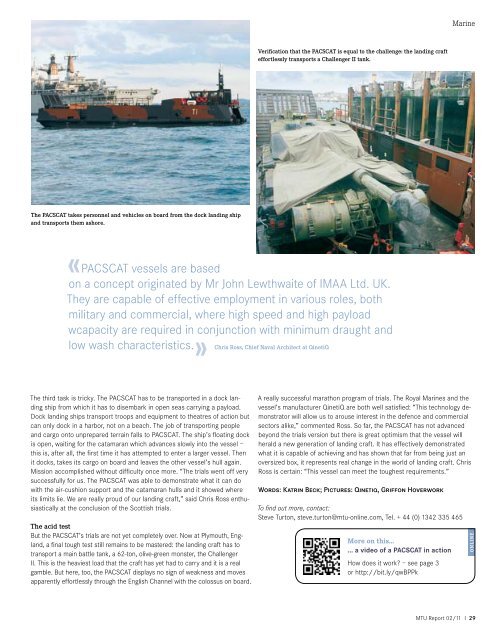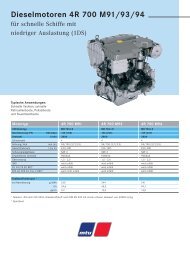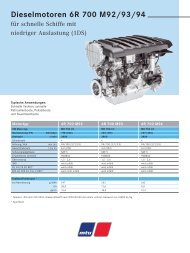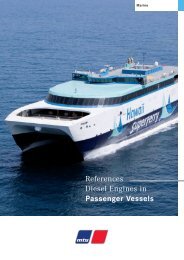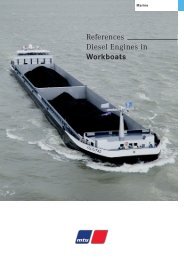You also want an ePaper? Increase the reach of your titles
YUMPU automatically turns print PDFs into web optimized ePapers that Google loves.
The PACSCAT takes personnel and vehicles on board from the dock landing ship<br />
and transports them ashore.<br />
The third task is tricky. The PACSCAT has to be transported in a dock landing<br />
ship from which it has to disembark in open seas carrying a payload.<br />
Dock landing ships transport troops and equipment to theatres <strong>of</strong> action but<br />
can only dock in a harbor, not on a beach. The job <strong>of</strong> transporting people<br />
and cargo onto unprepared terrain falls to PACSCAT. The ship’s floating dock<br />
is open, waiting for the catamaran which advances slowly into the vessel –<br />
this is, after all, the first time it has attempted to enter a larger vessel. Then<br />
it docks, takes its cargo on board and leaves the other vessel’s hull again.<br />
Mission accomplished without difficulty once more. “The trials went <strong>of</strong>f very<br />
successfully for us. The PACSCAT was able to demonstrate what it can do<br />
with the air-cushion support and the catamaran hulls and it showed where<br />
its limits lie. We are really proud <strong>of</strong> our landing craft,” said Chris Ross enthusiastically<br />
at the conclusion <strong>of</strong> the Scottish trials.<br />
The acid test<br />
But the PACSCAT’s trials are not yet completely over. Now at Plymouth, England,<br />
a final tough test still remains to be mastered: the landing craft has to<br />
transport a main battle tank, a 62-ton, olive-green monster, the Challenger<br />
II. This is the heaviest load that the craft has yet had to carry and it is a real<br />
gamble. But here, too, the PACSCAT displays no sign <strong>of</strong> weakness and moves<br />
apparently effortlessly through the English Channel with the colossus on board.<br />
Verification that the PACSCAT is equal to the challenge: the landing craft<br />
effortlessly transports a Challenger II tank.<br />
«PACSCAT vessels are based<br />
on a concept originated by Mr John Lewthwaite <strong>of</strong> IMAA Ltd. UK.<br />
They are capable <strong>of</strong> effective employment in various roles, both<br />
military and commercial, where high speed and high payload<br />
wcapacity are required in conjunction with minimum draught and<br />
low wash characteristics.» Chris Ross, Chief Naval Architect at QinetiQ<br />
A really successful marathon program <strong>of</strong> trials. The Royal Marines and the<br />
vessel’s manufacturer QinetiQ are both well satisfied: “This technology demonstrator<br />
will allow us to arouse interest in the defence and commercial<br />
sectors alike,” commented Ross. So far, the PACSCAT has not advanced<br />
beyond the trials version but there is great optimism that the vessel will<br />
herald a new generation <strong>of</strong> landing craft. It has effectively demonstrated<br />
what it is capable <strong>of</strong> achieving and has shown that far from being just an<br />
oversized box, it represents real change in the world <strong>of</strong> landing craft. Chris<br />
Ross is certain: “This vessel can meet the toughest requirements.”<br />
Words: Katrin Beck; Pictures: Qinetiq, Griffon Hoverwork<br />
To find out more, contact:<br />
Steve Turton, steve.turton@mtu-online.com, Tel. + 44 (0) 1342 335 465<br />
More on this...<br />
... a video <strong>of</strong> a pACSCAt in action<br />
How does it work? – see page 3<br />
or http://bit.ly/qwBPPk<br />
Marine<br />
ONLINE<br />
<strong>MTU</strong> Report 02/11 I 29


